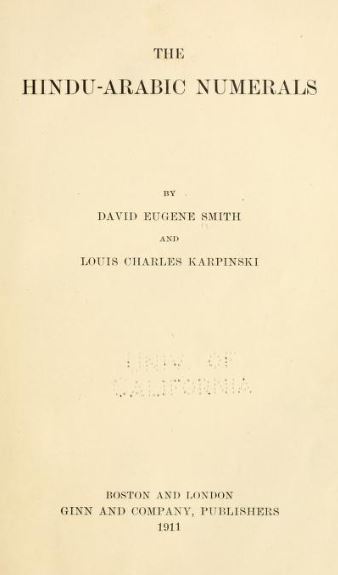‘The Hindu Arabic Numerals’ PDF Quick download link is given at the bottom of this article. You can see the PDF demo, size of the PDF, page numbers, and direct download Free PDF of ‘The Hindu Arabic Numerals’ using the download button.
The Hindu Arabic Numerals Book PDF Free Download

Early Ideas of Their Origin
It has long been recognized that the common numerals used in daily life are of comparatively recent origin.
The number of systems of notation employed before the Christian era was about the same as the number of written languages, and in some cases, a single language had several systems.
The Egyptians, for example, had three systems of writing, with a numerical notation for each; the Greeks had two well-defined sets of numerals, and the Roman symbols for numbers changed more or less from century to century.
Even today the number of methods of expressing numerical concepts is much greater than one would believe before making a study of the subject, for the idea that our common numerals are universal is far from being correct.
It will be well, then, to think of the numerals that we still commonly call Arabic, as only one of many systems in use just before the Christian era.
As it then existed the system was no better than many others, it was of late origin, it contained no zero, it was cumbersome and little used, and it had no particular promise.
Not until centuries later did the system have any standing in the world of business and science; and had the place value which now characterizes it.
And which requires a zero, been worked out in Greece, we might have been using Greek numerals today instead of the ones with which we are familiar.
Of the first number forms that the world used this is not the place to speak. Many of them are interesting, but none have much scientific value.
In Europe the invention of notation was generally assigned to the eastern shores of the Mediterranean until the critical period of about a century ago,—sometimes to the Hebrews, sometimes to the Egyptians, but more often to the early trading Phœnicians.
The idea that our common numerals are Arabic in origin is not an old one.
The mediæval and Renaissance writers generally recognized them as Indian, and many of them expressly stated that they were of Hindu origin.
Others argued that they were probably invented by the Chaldeans or the Jews because they increased in value from right to left, an argument that would apply quite as well to the Roman and Greek systems, or to any other.
It was, indeed, to the general idea of notation that many of these writers referred, as is evident from the words of England’s earliest arithmetical textbook-maker, Robert Recorde (c. 1542).
“In that thing, all men do agree, that the Chaldays, which first invented this rate, did set these figures as they set all their letters.
For they write backward as you tear it, and so do they read. And that may appear in all Hebrew, Chaldee, and Arabic books … whereas the Greeks, Latines, and all nations of Europe, do write and read from the left hand towards the right.”
Others, and among them such influential writers as Tartaglia in Italy and Köbe in Germany, asserted the Arabic origin of the numerals, while still others left the matter undecided or simply dismissed them as “barbaric.”
Of course, the Arabs themselves never laid claim to the invention, always recognizing their indebtedness to the Hindus both for the numeral forms and for the distinguishing feature of place value.
Foremost among these writers was the great master of the golden age of Bagdad, one of the first of the Arab writers to collect the mathematical classics of both the East and the West, preserving them and finally passing them on to awaken Europe.
This man was Moḥammed the Son of Moses, from Khowārezm, or, more after the manner of the Arab, Moḥammed ibn Mūsā al-Khowārazmī, a man of great learning and one to whom the world is much indebted for its present knowledge of algebra and of arithmetic.
Of him there will often be an occasion to speak; and in the arithmetic which he wrote, and of which Adelhard of Bath (c. 1130) may have made the translation or paraphrase, he stated distinctly that the numerals were due to the Hindus.
This is as plainly asserted by later Arab writers, even to the present day. Indeed the phrase ‛film hindī, “Indian science,” is used by them for arithmetic, as well as the adjective hindī alone.
| Author | David Eugene Smith |
| Language | English |
| No. of Pages | 184 |
| PDF Size | 9.2 MB |
| Category | Mathematics |
| Source/Credits | archive.org |
The Hindu Arabic Numerals PDF Free Download
